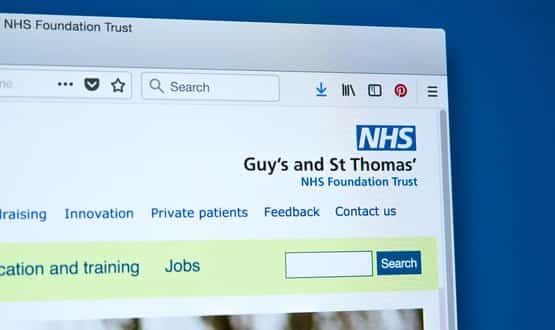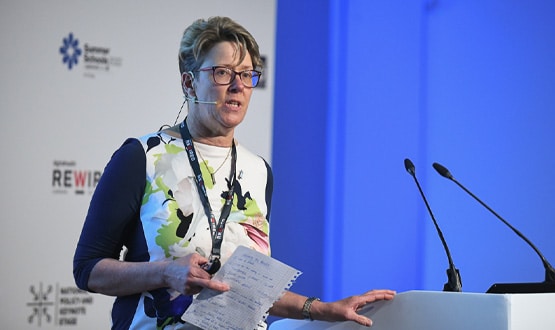£213m IT plan for Guy’s and St Thomas’
- 16 April 2012

Guy’s and St Thomas’ NHS Foundation Trust plans to invest £213m in IT over the next five years, including the procurement of an electronic patient record system, clinical portals and mobile devices for staff.
The trust’s IT strategy was passed by the board in December last year and sent out to suppliers.
It aims to achieve; a resilient infrastructure that will perform 24/7; a ‘third generation’ PAS/EPR with integrated major specialty systems; mobile working via portals; integrated research systems; and a network that extends beyond the hospital into the community.
The strategy sets out a total capital investment over the next five years of £113m, which is £65m more than the current planned spend of £48m.
There is also an anticipated total revenue requirement of £100m over the five year period, which is £40m above current revenue projections.
Group IT director Scott Sommerville said it was not a hard task to get the strategy passed by the board which, if anything, was keen to invest more money and faster.
“I was able to describe back to the organisation what its ambitions were and how technology needed to be used in order to achieve that,” he said.
Each project will be presented as an individual business case with costs and benefits. The first project, for a “noteless paper light” programme – is going to the board next month.
Guy’s and St Thomas’ is one of the iSoft7 group of trusts in London and the South that chose to stick with their iSoft i.PM and i.CM systems ahead of the National Programme for IT in the NHS.
This group recently agreed a new deal with CSC to retain their systems. But the Guy’s and St Thomas’ strategy says the clinical system – iCM – is “limited in scope for expansion.”
It also says the trust needs to make such a heavy investment in IT because there are problems with the multiple systems that staff have to use at the moment, which "have been developed incrementally without a coherent plan."
Work has been completed over the last two years on making the fixed network and wireless network more resilient and able to support the future needs of the trust.
However, the servers and storage used to deliver applications are in “varying states of reliability.”
The strategy document projects an investment of more than £25m in supporting infrastructure over five years. This new infrastructure will be capable of operating 24/7 and supporting a mobile workforce.
The plan is to implement an interim e-prescribing system in this financial year with a picture archiving and communications system and radiology information system likely to be rolled out over 2013-15.
But Guy’s and St Thomas’ wants to achieve a paperless environment with the implementation of the EPR, which is to be procured between 2013 and 2015.
Sommerville has built up the trust’s programme management office to run the strategy. He has also created a design team with a chief architect, enterprise and clinical architects doing detailed design work.
And he has commissioned a “root and branch audit” of the IT systems, processes and people to identify where the risks lay ahead.
“We will use consultants and suppliers to deliver a large part of the expertise. The key is that we retrain our people as we go through this process so we end up with the expertise in the organisation,” Sommerville said.
“It’s an ambitious plan, we need to be really diligent in our upfront planning and really professional in the way we approach this.
“I feel highly excited about it myself and the team are really quite energised. We look around the NHS and don’t see a lot of organisations attempting to do what we are doing.”
The cost of procuring an EPR and the development of big systems such as PACS over the next five years is estimated at more than £35m.
An estimated £8.4m will be invested in integrated desktops to provide a view of information pulled together from various systems.
Staff will have a single sign-on with automatic access to all the information they need to do their job, the strategy says.
The inpatient view will enable a “paperless ward” with live bed state and electronic ward observations and there will also be a community portal and GP portal.
New devices will be made available to support this new flexibile working environment such as lightweight laptops, tablets and small hand held computers.
A new programme called ‘Hospital in Pocket’, introduced this year, will see all existing phones, BlackBerry smartphones, bleeps and pagers replaced with a smaller number of standard devices.
Laptops will be developed with “offline” capabilities and tablet devices will be introduced alongside bedside terminals. In parallel to this, the trust will be investing nearly £13m in systems access services.
“Increasingly sophisticated software will be deployed to monitor and control staff access whilst simplifying the process of accessing trust systems and services,” the strategy says.
The trust is also looking to invest in video conferencing capabilities, which will ultimately be extended to patients in their homes, and explore the use of telemedicine, starting with A&E.




